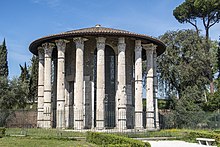art.wikisort.org - Sculpture
The Mouth of Truth (Italian: Bocca della Verità [ˈbokka della veriˈta]) is a marble mask in Rome, Italy, which stands against the left wall of the portico of the Santa Maria in Cosmedin church, at the Piazza della Bocca della Verità, the site of the ancient Forum Boarium (the ancient cattle market). According to enduring medieval legend, it will bite off the hand of any liar who places their hand in its mouth,[1] or, alternatively, any who utters a lie while their hand is in the mouth.[2] It still attracts many visitors who audaciously insert their hands.

 The Mouth of Truth | |
 Click on the map for a fullscreen view | |
| Location | Santa Maria in Cosmedin |
|---|---|
| Coordinates | 41°53′17″N 12°28′54″E |
The massive marble mask weighs about 1300 kg (2800 lbs) and probably depicts the face of the sea titan god Oceanus. The eyes, nostrils and mouth are open. Historians aren't quite certain what the original purpose of the disc was. It was possibly used as a drain cover in the nearby Temple of Hercules Victor, which had an oculus—a round open space in the middle of the roof, similar to that of the Pantheon. Hence, it could rain inside. It is also thought that cattle merchants used it to drain the blood of cattle sacrificed to the god Hercules. In the thirteenth century the disc was probably removed from the temple and placed against the wall of the Santa Maria in Cosmedin. In the seventeenth century it eventually moved to its current location inside the portico of the church.
Cultural references and derivative works

The Mouth of Truth has been featured as a theme in historical European art. Lucas Cranach the Elder, a German painter during the Renaissance period, created two paintings depicting a woman placing her hand in the mouth of a statue of a lion while onlookers watched, a subject which was drawn by Albrecht Altdorfer and made into a woodcut by the Dutch printmaker Lucas van Leyden.[3]
The Mouth of Truth is now known mostly from its appearance in the 1953 film Roman Holiday. The film also uses the Mouth of Truth as a storytelling device since both Hepburn's and Peck's characters are not initially truthful with each other. In Het geheim van de afgebeten vingers by Dutch writer Rindert Kromhout,[4] the fingers of lying children are cut off with a scythe by a skeleton who lives in the Capuchin Crypt in the Santa Maria della Concezione dei Cappuccini.
There are a number of Bocca della Verità replicas and derivative works. A full-size reproduction sits in the Alta Vista Gardens in California and one of Jules Blanchard's sculptures in the Luxembourg Garden in Paris depicts a woman with her hand in the sculpture's mouth. Coin-operated fortune teller machines have been developed and installed in different parts of the world, including one on display in the Musée Mécanique in San Francisco.[5][6]
Gallery
- Side view of Bocca della Verità.
- La Bocca della Verità, statue by Jules Blanchard, in the Luxembourg Garden, Paris.
- The empress and the Mouth, here shown as a statue of a lion, in a German plaquette of c. 1550.
- Bocca della Verità fortune teller machine at the Musée Mécanique in San Francisco.
Notes
- Henry V. Bender (1985). The Civilization of Ancient Rome: An Archaeological Perspective, Beginnings to Augustus. University Press of America. p. 58. ISBN 978-0-8191-5082-0.
- John Henry Middleton (1892). The Remains of Ancient Rome. A. and C. Black. p. 195.
- "Property From An Important European Private Collection - Lucas Cranach the Elder". sothebys.com.
- Telkers, Anne (18 May 2001). "De eerste beursdag in Turijn". Boekblad. Retrieved 25 March 2015.
- "BOCCA DELLA VERITA' facts and history". Dpsusa.com. Retrieved 2012-12-20.
- Nolte, Carl (27 February 2002). "Old and in the way / The Musee Mecanique will soon be history". San Francisco Chronicle. Retrieved 19 November 2016.
References
- Snyder, James. Northern Renaissance Art, 1985, Harry N. Abrams, ISBN 0136235964
External links
 Media related to Bocca della Verità at Wikimedia Commons
Media related to Bocca della Verità at Wikimedia Commons
| Preceded by Colossus of Constantine |
Landmarks of Rome Bocca della Verità |
Succeeded by Laocoön and His Sons |
На других языках
[de] Bocca della Verità
Die Bocca della Verità (deutsch „Mund der Wahrheit“) ist ein scheibenförmiges Relief, das an der linken Schmalseite in der Säulenvorhalle der römischen Kirche Santa Maria in Cosmedin angebracht ist. Der Name Bocca della Verità wurde erstmals 1485 urkundlich erwähnt. Das etwa 2000 Jahre alte, antike Relief befindet sich seit 1632 in der Vorhalle der Kirche.- [en] Bocca della Verità
[es] Bocca della Verità
La Boca de la verdad (en italiano: Bocca della Verità) es una antigua máscara de mármol pavonazzetto, colocada en la pared del pronaos de la Iglesia de Santa Maria in Cosmedin, construida sobre un antiguo templo de Hércules en Roma el año 1632.[it] Bocca della Verità
La Bocca della Verità è un antico mascherone in marmo pavonazzetto, murato nella parete del pronao della chiesa di Santa Maria in Cosmedin di Roma dal 1632. Il mascherone rappresenta un volto maschile barbuto; occhi, naso e bocca sono forati e cavi. Il volto è stato interpretato nel tempo come raffigurazione di vari soggetti: Giove Ammone, il dio Oceano, un oracolo o un fauno.[ru] Уста истины
«Уста истины» (итал. Bocca della Verità) — античная круглая мраморная плита с изображением маски Тритона (или Океана), датируемая I веком н. э. и расположенная с XVII века в нартексе церкви Санта-Мария-ин-Козмедин в Риме. В Средние века с этим диском было связано поверье, что если лжец вставит руку в отверстие, выполненное в виде рта божества, то божество её откусит. Широкую известность в мире эта легенда получила после выхода на экраны американской романтической комедии «Римские каникулы» (реж. Уильям Уайлер, 1953).Другой контент может иметь иную лицензию. Перед использованием материалов сайта WikiSort.org внимательно изучите правила лицензирования конкретных элементов наполнения сайта.
WikiSort.org - проект по пересортировке и дополнению контента Википедии




